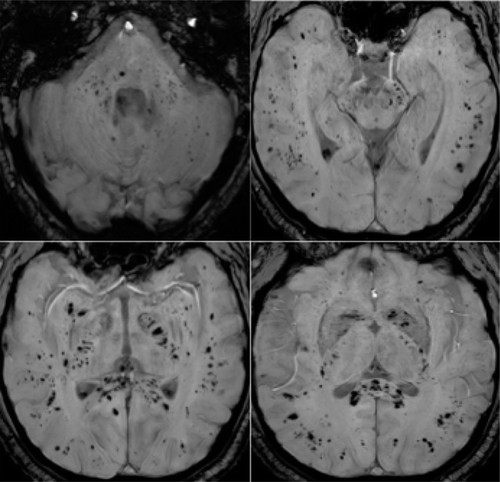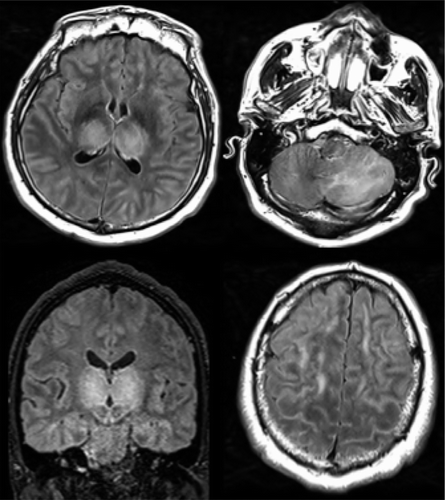MRI Pinpoints Non-Stroke Abnormal Brain Findings in COVID-19-Positive Patients
Three patterns emerge in patients analyzed in multi-institutional study.
Patients with COVID-19 infection display abnormal brain findings other than stroke on MRI, new research has revealed.
Published on June 16 in Radiology, data from a multi-institution study revealed that three neuroradiological patterns occur most frequently in this group. Overall, there is relatively little evidence and data about the neurological impacts of COVID-19, but as the outbreak continues, the body of information continues to grow, said the research team led by Stéphane Kremer, M.D., from the Hôpitaux Universitaires de Strasbourg in France.
57-year old man with pathological wakefulness after sedation. Extensive and isolated white matter microhemorrhages. Axial Susceptibility weighted imaging (SWI) (A, B, C, D): multiple microhemorrhages mainly affecting the subcortical white matter, corpus callosum, internal capsule, and cerebellar peduncles. Courtesy: Radiology

“Three main neuroradiological patterns could be distinguished, and the presence of hemorrhage was associated with worse clinical status,” Kremer’s team wrote.
Related Content: What COVID-19 Brain Abnormalities Could Mean
These patterns identified in patients were:
- Signal abnormalities located in the medial temporal lobe (43 percent)
- Non-confluent multifocal white matter hyperintense lesions on FLAIR and diffusion sequences, with variable enhancement, with hemorrhagic lesions (30 percent)
- Extensive and isolated white matter microhemorrhages (24 percent)
It is important to note, the investigators said, that MRI scans revealed hemorrhage in 54 percent of patients and that those individuals had worse respiratory, neurological, and biological status. Additionally, SARS-CoV-2 RNA was only found in the cerebrospinal fluid of one patient, leaving the direct implications of the virus still unclear.
51-year old man with impaired consciousness. Acute necrotizing encephalopathy. Axial FLAIR (A, C, D), and coronal FLAIR (B): bilateral FLAIR hyperintensity (cross) in both thalami (A, B), associated with involvement of the cerebellar (C), and cerebral (D) white matter (arrows). Courtesy: Radiology

To determine the neurological impacts, the team retrospectively examined 1.5T or 3T MRI scans conducted between March 23 and April 27, 2020, on 37 patients who were COVID-19-positive with neurological manifestations. The patients – 30 men and 7 women – were seen in one of 16 French medical facilities, including 11 university hospitals and five general hospitals.
Of the group, 73 percent experienced altered consciousness, 41 percent had pathological wakefulness when any sedation wore off, 32 percent were confused, and 19 percent were agitated. Twenty-six patients underwent an EEG, and seven (27 percent) were diagnosed with encephalopathy and one (4 percent) had a case of seizures. In addition, 31 patients had a lumbar puncture, revealing that 21 individuals (68 percent) had increased markers of inflammation.
Although these results further expand the knowledge base of how COVID-19 affects the brain, more work is needed to fully understand the impact, the team said.
“Imaging and neurological follow up has to be undertaken in order to evaluate the prognosis of these patients,” they said.
Study: Monitoring of Prostate MRI Exams Could Lead to 75 Percent Reduction of Gadolinium Contrast
March 17th 2025While DCE MRI was deemed helpful in over 67 percent of cases in which it was used, researchers found that monitored prostate MRI exams, which facilitated a 75 percent reduction of DCE MRI sequences, had comparable sensitivity for prostate cancer as non-monitored exams.